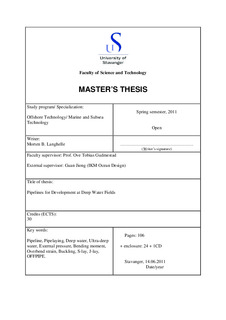| dc.description.abstract | Oil and gas fields are today being developed at water depths characterized as ultra-deep waters, in
this report limited to 3500 meters. Pipelines, which are major components of these developments,
will experience challenges both in terms of design and installation. The installation processes require
special focus, as heavy pipelines may exceed the lay vessels’ tension capacities in these water depths.
A single steel pipeline is the most applied concept for deep water field developments due to its
simple engineering concept, well known behavior and cost effectiveness. Pipe-in-Pipe solutions are
thermally efficient and are a proven technology, but applications are limited due to economical and
technical aspects restricting the sizes and weights applicable for installation in deep waters.
Sandwich pipes can maintain a thermal and structural performance close to Pipe-in-Pipe systems,
with a lower submerged weight. This is however a relatively new concept that demands further tests
and studies in order to be applicable at ultra-deep water fields.
Design to withstand buckling during the installation process requires thick walled pipelines due to the
combination of high external hydrostatic pressure affecting pipes at these depths and the bending
during the pipe laying process. Given that existing lay vessels have limited tension capacities to
reduce the bending radius, measures must be implemented, both in terms of pipeline design and lay
vessel configurations, to allow for ultra-deep water installation.
The thesis comprises development of 14 inch, 20 inch and 28 inch steel pipelines for installation at
water depths down to 3500 meters. Investigations are made on the effects of selecting pipelines with
higher steel grades than the conventional X65. Static analysis studies are in addition made on the
feasibility of installing these pipelines in deep- and ultra-deep waters, and to investigate limiting
factors in the installation processes. Laying analyses are performed with OFFPIPE which provides
results on bending moments, strains, and axial tensions affecting and limiting the layability. Further
studies are performed on the effects an increased allowable overbend strain (up to 0,35%) will have
on the installation process, and to understand the correlation between this factor and other
parameters such as stinger radius, departure angle, top- and residual tension and bending moments.
Wall thickness parameter studies indicate that the use of higher steel grades will have a significant
contribution in pipeline wall thickness reduction. The percentage reduction in wall thickness is
greater for increasing water depths when higher steel grades are considered. This has a direct impact
on the total weight of the pipeline segment to be installed in deep waters and thus selection of lay
vessel. The associated cost reductions could also be substantial.
Static lay analyses show that large diameter pipelines have limited possibilities of being installed with
existing lay vessels at ultra-deep waters down to 3500 meters. It can be concluded that increased
allowable overbend strain have several advantages for the installation processes and will extend the
water depths possible for pipe installation with existing S-lay vessels. Overbend strains are not an
issue for J-lay vessels, where installation of large diameter pipelines can be performed to water
depths of 3500 meters by increasing tensioning capacities of existing J-lay vessels. | en_US |
